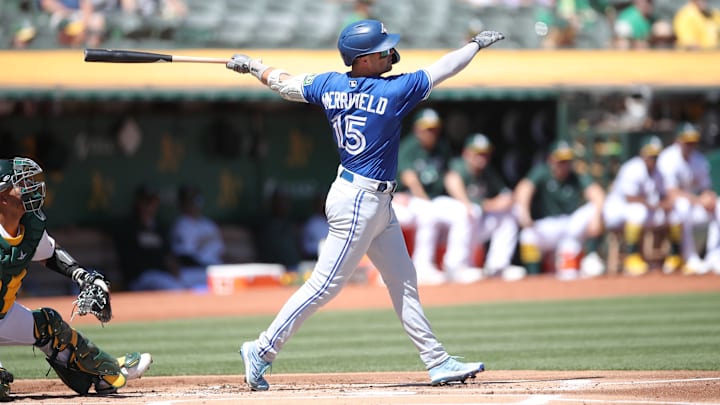Whit Merrifield is no Shohei Ohtani. He was, surprisingly, selected as an All-Star but ended the year with a slash line of .272/.318/.382 for an OPS of .700 and an OPS+ of 94. His ability to switch between being a second baseman and corner outfielder was valuable for the Toronto Blue Jays this past year but with just 0.7 rWAR, it doesn't seem like it really moved the needle. Nonetheless, with the available position player free agents, it's important that the Mariners leave no stone unturned. Let's take a look at whether Merrifield would be able to add value to a contending Seattle team.
The main driver behind his lack of offensive prowess was his low exit velocity. His average exit velocity in 2023 was just 85.1 mph, fourth-worst among qualified players. This characteristic also stunted his barrel (2.4%, 3rd percentile) and hard-hit (24.3%, 2nd percentile) rates, bringing his expected slugging and expected weighted on-base average to .329 (5th percentile) and .274 (4th percentile) respectively. Even his home runs can exit the park at a slower-than-expected speed.
Home Run — Whit Merrifield (9)
— Blue Jays Videos (@BlueJaysVideos) September 25, 2023
Distance — 354 ft
Exit Velo — 96.1 MPH
Pitcher — Yennier Cano
Opponent — Baltimore Orioles
Date — 07/31/2023#NextLevel pic.twitter.com/3WBv4089t5
It's surprising that he was even able to produce the OPS he did because players with similar exit velocities often ended up performing even worse.
Player | Average Exit Velocity (mph) | OPS |
|---|---|---|
Esteury Ruiz (OAK) | 82.7 | .654 |
Brice Turang (MIL) | 85.5 | .585 |
Paul DeJong (SFG) | 85.5 | .613 |
Will Brennan (CLE) | 85.7 | .655 |
There were some exceptions, like Jake Fraley, Jon Berti, and Jose Altuve who average velocities of <=86.0 mph but were still able to be productive, but without the proper placement and also a below-average walk rate (6.1%, 19th percentile), Merrifield was not one of the few players that were able to work around soft contact.
On the bright side, Merrifield was able to compensate for his lack of exit velocity with good launch angles, finding the sweet spot 37.2% of the time (81st percentile). He also whiffed and struck out less than league average, helping him to maintain a respectable batting average. He's also a pretty speedy guy, topping out at 28.7 feet/second, faster than 85% of the league.
In addition to his below-average production at the plate, his defense left a little to be desired, logging -1 outs above average and a total of -8 defensive runs saved, split evenly between his time at second base and in the outfield.
So is it worth it?
Whit Merrifield should probably be seen as a "break glass in case of emergency" sort of free agent acquisition. Outside of a small handful of far-too-old or far-too-expensive names like Evan Longoria and Cody Bellinger, there really isn't a ton of positional talent to be excited about. Furthermore, the Mariners, interestingly enough, already have a player who can play both second base and the outfield: Dylan Moore. He posted a .731 OPS and a 104 OPS+ and had 0.5 rWAR with 400 fewers at-bats. He's signed through 2025 at a very team-friendly $8.88 million over three years.
If Seattle was able to get the 2021 version of Whit Merrifield who had a similar OPS at .711 but had 14 defensive runs saved as a second baseman, it might worth their time to pursue him. However, with MLBTradeRumors projecting him to earn $18 million over two years with a team far more desperate for any roster talent (aka, the Chicago White Sox), it simply doesn't make financial or baseball sense for the front office to acquire him.
